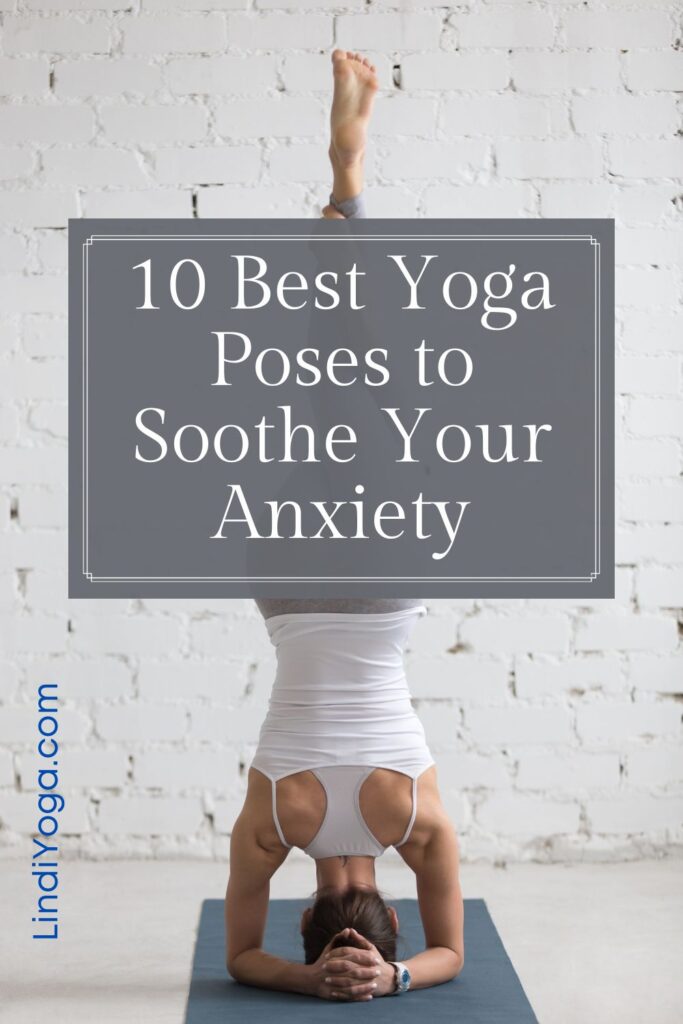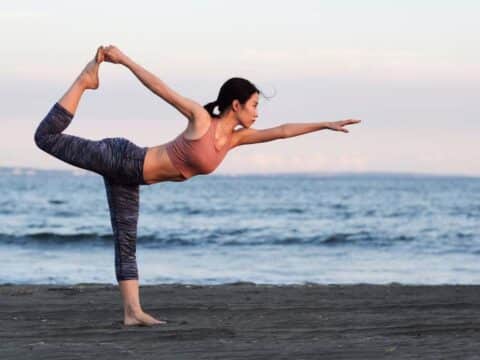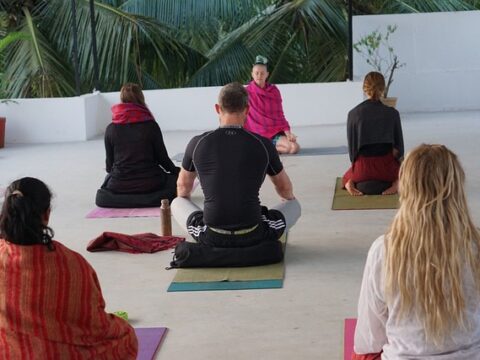Can Yoga for anxiety really help? There are many benefits to practicing yoga, but one of the biggest is anxiety relief. Anxiety can be a very real thing, and it affects a lot of people.
Yoga can help you with anxiety because it helps your body relax. When your muscles are relaxed, it’s easier to cope with stress and anxiety. You’ll also notice that as you learn to control your breath, you’ll feel calmer and less anxious.
In addition to this, yoga can also help you develop a better sense of calmness and peace. That kind of peace is a very important part of dealing with anxiety, so you should definitely consider adding some yoga to your routine.
What does practicing yoga have to do with anxiety? In fact, yoga can be extremely beneficial to people who suffer from anxiety and depression. Here’s why!
Podcast
Anxiety and depression often go hand in hand, so it’s no wonder that many people who suffer from these conditions also find yoga helpful. Yoga helps people with anxiety and depression because it focuses on controlling your breathing, which reduces anxiety. This in turn can help you to deal with anxiety better.
If you have struggled with anxiety for a long time, you might be interested in doing some research on yoga. The practice can actually reduce anxiety within minutes, and has been shown to reduce stress levels, too.
Yoga also teaches people how to relax, and this can help them deal with stress. It has been shown that this type of relaxation can reduce the severity of anxiety. Yoga also helps with meditation, which can be beneficial to people who struggle with anxiety. People who practice yoga can also gain better posture, which is very important when dealing with anxiety.
It’s important to remember that practicing yoga is not the same as taking medication. You don’t need to have a license to practice yoga, and you don’t have to pay a large fee to learn about it. In fact, you can easily learn about yoga for free, and there are many resources available online. You just need to search for them.
The practice of yoga is beneficial to people who suffer from anxiety and depression, and yoga is a great way to combat these problems. While it may not cure anxiety, it will at least help you manage it. The next step is to find out how you can start practicing yoga today!
Yoga’s calming effect on both the body and mind can help reduce anxiety symptoms.
Practicing yoga and pranayama for anxiety helps:
- Muscle relaxation
- Increase body awareness
- Better focus on the present moment
- Reduce the feelings of stress and anxiety
- Enhance mood and the sense of well-being
- Slows brain activity associated with anxiety
- Produces in the brain theta waves
- Synchronizes the activity of the heart and lungs
- Enhances physiology and biochemistry
- Support connections when done in a group
- Drives you away from negative thoughts
Anxiety is a natural human emotion. But it doesn’t have to be. Yoga is a great way to learn how to control your emotions, and this article gives some tips on how to do it. When we’re anxious, our body is out of balance. We feel stressed and tense, our breathing is too fast, and our muscles are tight. This is because we are thinking too much about what’s going to happen next, instead of living in the moment and relaxing.
Yoga helps us to learn how to live in the present moment and relax. The more we practice yoga, the more it becomes natural. And when we feel relaxed, we tend to think more rationally and logically. We also learn how to focus on something else besides ourselves. When we are anxious, we think about what’s happening inside our bodies, and worry about what our friends are saying about us. Instead of focusing on these things, we can learn to focus on something else.
If you’re feeling anxious, try doing some deep breathing exercises. Take three slow, deep breaths, and then let go of everything you’re worried about. Try repeating a mantra, or simply focus on a color or image.
If you have anxiety issues, you might want to try yoga. This type of exercise focuses on controlling the mind, and it teaches you to calm your body.
Yoga Poses to combat Anxiety
Stop and take a few minutes to do some yoga poses when you start to feel stressed or anxious. This will help to calm your nervous system and make you feel more focused so that you can deal with whatever challenges you are facing.
Here are six yoga poses for anxiety to try when you’re feeling restless or uneasy:
Seated Forward Bend (Paschimottanasana)
The Forward Bend is one of the easiest poses in yoga. It strengthens your spine, builds strength and stability in the hip joints, and improves range of motion in the back. Forward Bends are a great addition to your daily routine, as they help to improve flexibility and overall physical health. They can help reduce pain and stress, and they are great for toning your core and improving your posture.
Short version of the sequence
- To begin, sit on the floor with your legs straight out in front of you and your back pressed against a wall.
- Lean forward so that your head rests on the floor, while your shoulders are directly in contact with the wall.
- You should feel both your thighs and buttock pressing firmly against the wall.
- Inhale deeply and let your arms fall down to your sides, while holding onto the wall. Hold this position for at least 3 breaths before releasing.
- Exhale and return to an upright seated position.
- You can either rest here or continue to deepen the pose. For example, if you are sitting comfortably, extend your left leg straight behind you, bend your right knee and place your foot on your lower thigh.
- Your palms are facing down towards the ground, and you can hold onto the wall with your right hand or simply reach down and grasp your left foot. If you are comfortable with this position, keep your body aligned and inhale deeply as you press into your legs and torso.
- Hold the pose for at least 10 breaths, and then release.
If you would like to move deeper into the pose, you can also cross your right ankle over your left thigh and place your hands on the floor.
Butterfly Pose (Baddha Konasana)
This pose helps you to clear the mind and relax. Have you ever found yourself getting stressed out, worried, or anxious? This pose can help to calm you down, and give you a break from whatever is bothering you. The butterfly pose is also known as the cocoon pose. This is because when you are doing this pose, it is like you are being protected by your own shell. And as a result of that, you feel safe and protected.
Short version of the sequence
- Start by sitting on the ground with your legs extended out in front of you.
- Take your arms in towards your chest, and cross them in front of your body.
- Inhale and raise your arms to the sky, allowing your palms to touch the floor.
- Exhale and slowly lower your arms back down.
- Once you have lowered your arms, place your hands back on your thighs.
- Bring your fingertips to your knees.
- Now, turn your palms face up.
- Inhale, and lift your arms up towards the sky.
- Slowly, bring your hands to your chest, and hold them there.
- Slowly bring your hands closer to your heart.
- Hold this position for 3-5 breaths.
- Repeat the entire process 3-4 times.
- Now that you have completed the first part of the butterfly pose, it is time to move on to the second part.
- Start by bringing your hands to your stomach.
- As you inhale, lift your hands up above your head.
- Allow them to float above your head.
- Keep your elbows wide.
- Exhale and lower your hands to your knees.
- If you feel comfortable, you can slowly bring your hands to your thighs.
- Place your hands in the same position as before.
- Repeat the entire process 3-4 times.
Extended Triangle Pose (Utthita Trikonasana)
This pose is an advanced exercise that requires you to learn a few key points before you attempt it. In yoga, extended triangle poses are usually only practiced by advanced yogis because they can cause some intense back pain, especially when first attempted. However, once you become more familiar with the posture, you can make it easier to practice. If you struggle with anxiety, then you need to try extended triangle pose, it’s awesome yoga pose to deal with anxiety.
Short version of the sequence
- Stand straight and tall.
- Spread your hands wide.
- Bring your right hand to the back of your head.
- Bring your left hand to the front of your chest.
- Put your right foot on the floor in front of your left foot.
- Bend your left arm and reach down toward your left shoulder.
- Bring your right foot forward.
- Turn your head to look at your right hand.
- Stretch your neck by turning your head even more.
- Bend your knees and lean forward a little.
- Pull your right arm toward you and cross your elbows over your body.
- Lift your chin a little higher than your elbow.
- Lift your heels a little off the floor.
- Relax and take a deep breathe.
- Lower your head and roll forward.
- Put your arms on the floor in front of you.
- Extend your legs and relax your body.
- Sit up straight again.
- Look toward the floor.
- Take a deep breathe and repeat.
Bridge Pose (Setu Bandha Sarvangasana)
Setu Bandha is a great way to release anxiety and stress. In fact, this pose can help you become more mentally and physically fit. So let’s learn how to do this pose properly. This pose can be used in combination with other poses, or as a stand-alone. You can also practice it between two poses, such as Trikonasana (Triangle Pose). When you practice Setu Bandha Sarvangasana, your heart rate will go down, and you’ll calm your mind. It’s a great way to relax and clear your head.
Short version of the sequence
- Place your arms on your thighs, and fold forward.
- Bring your forehead down toward your knees.
- Engage your legs and back.
- Raise your arms, and place your palms on the floor.
- Exhale.
- Now lift your head, and take a deep breath in.
- Breathe out as you reach for the ceiling with your arms.
- Keep your elbows bent and parallel to the ground, and stretch your fingers wide apart.
- Take three breaths in this position.
- On your next exhalation, slowly bring your head back toward the floor.
- On your next inhalation, raise your hips and chest off the floor.
- Let gravity take your upper body.
- Let your head drop, and turn your chin to the side.
- This will stretch your shoulders.
- Next, straighten your arms and lift your hips and chest off the floor.
- Again, let gravity take you.
- Try to keep your spine long, and your chest open and relaxed.
- The closer your chin is to the floor, the more you will stretch your neck.
- If you find yourself holding your breath, exhale completely, and relax.
- Repeat this exercise five times.
Half Moon Pose (Ardha Chandrasana)
Half Moon Pose (Ardha Chandrasana) is a relaxing yoga pose that helps improve overall flexibility. In addition, it’s a great posture to help reduce stress and anxiety.
Short version of the sequence
- Start By Standing
- Begin by standing up straight with your feet together. Your feet should be hip-width apart. Hold your arms out to your sides.
- Take a Deep Breath
- Take a deep breath in through your nose and out through your mouth. As you breathe in, feel the air fill your lungs. Do not hold your breath in.
- Raise Your Arms
- Slowly raise your arms up until they reach shoulder height. Place your fingers together. Relax your shoulders and let them fall down your back.
- Move Forward
- Step forward with one foot. Use your back heel to step forward so your front foot is in line with your rear foot. You should feel a stretch in your lower back.
- Lower Back
- As you step forward, slowly bend your knees. Bring your right knee up to meet your chest. Allow your left leg to hang down next to your body.
- Move Your Hands
- Your right hand should come around and grasp the inside of your left knee. Your left hand should remain behind your back. Move your right elbow towards your left knee.
- Relax Your Face
- Slowly relax your face as you look over your right shoulder. Look over your left shoulder and look up towards the sky. Let go of any tension in your face.
- Slowly Lower Your Arms
- As you take your arms back down to your sides, notice any sensations in your neck and back. Slowly move your arms back down. Your hands should be in front of your chest.
- Repeat on the Left Side
Legs-Up-The-Wall Pose (Viparita Karani)
This pose, called viparita karani, is one of the most popular poses for beginners. It can help to relieve stress, lower blood pressure, and even increase oxygen levels in the body. This pose has many names, including cat cow pose, legs-up-the-wall, and headstand. It’s also known as the King of Poses. This pose calms both the mind and the body, and it opens the lungs, expands the rib cage, and improves circulation. It’s also great for those with back problems.
Short version of the sequence
To begin, place your left leg up against the wall behind you. You should be facing away from the wall, with your right leg bent behind you. Cross your left arm over your chest, placing the palm of your hand on top of your other arm.
If you feel comfortable, you can rest your head on the floor. But if you would prefer to keep your neck and shoulders straight, you can place a cushion under your head. You can also raise your arms above your head and place your hands on the wall behind you. Either way, this posture is a great way to stretch out your spine and provide yourself with a sense of calm and relaxation.
Child’s Pose (Balasana)
In order to understand how to do the Child’s Pose, you first need to know what it is. So if you aren’t familiar with this pose, read on to find out more about it.
The Child’s Pose, or Balasana, is a basic yoga posture that helps improve balance and flexibility. It is often used to open the hips, and it is said to be particularly helpful for those who suffer from anxiety.
Short version of the sequence
In order to do the Child’s Pose, you’ll first need to kneel on the ground, and place your hands underneath your shoulders. You can then move your knees forward and back until you are comfortable. This helps to bring your chest closer to the ground, which makes it easier to breathe.
Once you are comfortable with your position, you can bring your elbows into the mat and slide your hands down your legs. You can then pull your knees towards your chest, so that your thighs are parallel to the floor.
You can do this pose in a number of different ways, but one of the easiest is to bend your knees and move your feet out in front of your body. Then, slide your feet close together, and use your hands to pull your knees towards your chest.
When doing this pose, you should focus on relaxing your muscles and breathing deeply. You can practice this pose every day to increase your flexibility and balance.
Cat Pose (Marjaryasana)
Have you ever seen a cat pose? If you have, it may be easy to see why this pose has such powerful benefits. This is the most relaxing pose that you will ever learn, and it will help you to feel calmer, happier, and more balanced.
Short version of the sequence
- Start in a comfortable position, with your knees bent and feet hip width apart.
- Let’s take a few moments to get into the right position before starting
- Take a deep breath and imagine that you are pulling your rib cage and chest out.
- Then, exhale and lean forward.
- Now, it’s time to slowly inhale and exhale, pulling your chest back and raising your rib cage.
- Remember to keep your back straight throughout this pose.
- Focus on your breathing, feel the air moving through your nostrils and into your lungs.
- Just allow yourself to relax and release any tension.
- As you breathe out, imagine that you are letting go of your rib cage and pulling your stomach up towards your back.
- When you exhale, imagine you are arching your head back.
- Keep your chin parallel to your chest throughout this pose.
- When you exhale, raise your arms overhead, reaching them above your head as you push your hips back.
- Once you are finished with this pose, repeat it twice.
Standing Forward Bend (Uttanasana)
The Standing Forward Bend will also open up your hips and lower back, allowing you to stretch out those areas. So this pose should not only help you feel relaxed, but it should also help you to achieve better health.
Short version of the sequence
- Take a deep breath, then inhale and push your chest forward.
- Exhale and bend forward as far as you can without losing your balance.
- Hold this position for 10-15 seconds, then slowly come back to standing position.
Camel Pose (Ustrasana)
If you are struggling with anxiety, there are several great ways to help you get through it. One of those ways is to learn how to do the Camel Pose (Ustrasana). The Camel Pose, or Ustrasana, is an exercise that helps to calm the mind, reduce stress, and strengthen the heart. It also gives you a sense of inner peace and helps to clear the head.
If you struggle with anxiety, you may want to learn how to do this exercise. The Camel Pose has been practiced by yogis for thousands of years, and it has helped people from all different walks of life.
Short version of the sequence
- Stand with your feet together.
- lace your arms up behind your back.
- Lift both of your knees until your thighs are parallel to the floor.
- Place your hands on top of your knees, keeping them close together.
- Stretch your spine, as if you were standing in front of a mirror.
- Lean forward so that your body forms a straight line from your ankles to your chin.
- Breathe slowly and deeply, filling your lungs with oxygen.
- Exhale slowly and keep your chin up.
- Hold this position for five to ten breaths.
- Relax your hands and let them fall by your sides.
- Let go of your legs, and return to the starting position.
- Repeat this process three times.
While doing this pose, try to feel your breathing and concentrate on the feeling of peace that this pose brings to you.




